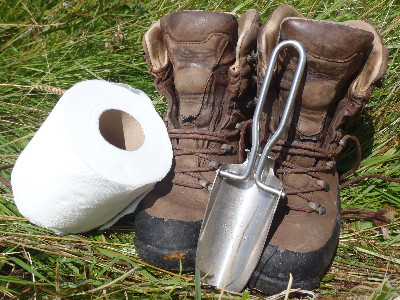
Dealing with human waste in a hygienic and environmentally sensitive way is a vital outdoor skill.
And since most of us are brought up to use indoor, flushing toilets, itís a skill that has to be learned like any other.
So what do you do when you need the loo, and there arenít any facilities nearby?
First thing is do you need to pee or poo?
Urinating is fairly straightforward Ė donít pee near open water or burns and stay well away from your campsite, buildings or near any other shelter. The Scottish Outdoor Access Code suggests at least 30m away. Wash your hands with water or use hand sanitiser afterwards.
Disposing of solids is something that demands more thought and pre-planning.
It is best to use toilets before you head out if they are available. If it is a composting toilet, be sure to follow the instructions, otherwise it may not work properly. If you are hillwalking or wild camping there may not be sanitary facilities anywhere near, so it is essential to plan for this.
There are two options: dig a hole and bury it, or bag it and carry it out.
There isnít a mountaineering culture of bagging and binning poo in the UK and some may find this thought distasteful. However, with a little thought it is a simple and safe option and may be the best option where it looks difficult to dig a pit to bury it.
It wonít always be possible to bury your waste. You may find you are unable to get a good distance away from water and buildings, or that that the ground is not suitable for digging a pit. This is likely to be the case at higher altitudes where bagging and carrying out will be the best option. Itís not a good idea to bury it in a small cairn of rocks for others to find later on.
It may be worth considering taking special outdoor poo packs or, if you are near to your vehicle, a portable toilet.
There are a number of germs and other nasties that can be transferred from excrement through drinking infected water.
Some areas of land will be sensitive to waste being added, especially if there is a cumulative effect from numbers of people.
It looks and smells terrible, and detracts from the joys of walking and camping.
Even if you find yourself without your poo-kit in your rucksack the basic advice remains the same.
Find an area away from open water, watercourses, paths, summit areas and places where others might shelter. That includes in the lee of large boulders, behind buildings etc.
Look for a depression in the ground or a place that has sufficient soil to be easily dug out, with some nearby damp moss or other natural material to use as toilet paper. Further excavate the depression in the ground by scraping and kicking with your foot or use a stick or similar object. If deep soft moss is present, you can often create a good result simply by using your hands to lift it aside. Any loose stones can also be moved by hand to deepen the depression.
Now use the depression to do your poo. Damp moss makes the ideal substitute for toilet paper, indeed many find it even better than toilet paper. Place the used moss on top of the poo, which helps to start covering it up.
Cover the poo with the material you initially dug out of the depression. Add to this by kicking and scraping more material from around the depression to create a thick layer of organic material over the waste. Ideally use soil, moss, dead wet leaves, etc. Use whatever is available. This will make it odour proof and help it to decompose.
On top of this place stones or large branches so that dogs and other animals cannot get access and dig up the waste.